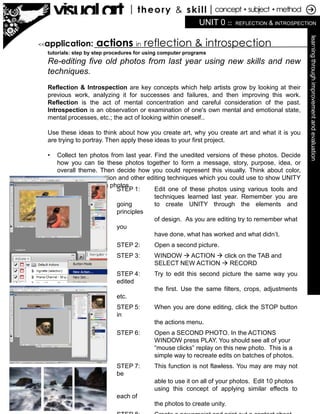Unit 1 creating unity
- 1. UNIT 0 :: REFLECTION & INTROSPECTION learningthroughimprovementandevaluation tutorials: step by step procedures for using computer programs Re-editing five old photos from last year using new skills and new techniques. Reflection & Introspection are key concepts which help artists grow by looking at their previous work, analyzing it for successes and failures, and then improving this work. Reflection is the act of mental concentration and careful consideration of the past. Introspection is an observation or examination of one's own mental and emotional state, mental processes, etc.; the act of looking within oneself.. Use these ideas to think about how you create art, why you create art and what it is you are trying to portray. Then apply these ideas to your first project. • Collect ten photos from last year. Find the unedited versions of these photos. Decide how you can tie these photos together to form a message, story, purpose, idea, or overall theme. Then decide how you could represent this visually. Think about color, contrast, composition and other editing techniques which you could use to show UNITY between these ten photos. <<application: actions in reflection & introspection STEP 1: Edit one of these photos using various tools and techniques learned last year. Remember you are going to create UNITY through the elements and principles of design. As you are editing try to remember what you have done, what has worked and what didn’t. STEP 2: Open a second picture. STEP 3: WINDOW ACTION click on the TAB and SELECT NEW ACTION RECORD STEP 4: Try to edit this second picture the same way you edited the first. Use the same filters, crops, adjustments etc. STEP 5: When you are done editing, click the STOP button in the actions menu. STEP 6: Open a SECOND PHOTO. In the ACTIONS WINDOW press PLAY. You should see all of your “mouse clicks” replay on this new photo. This is a simple way to recreate edits on batches of photos. STEP 7: This function is not flawless. You may are may not be able to use it on all of your photos. Edit 10 photos using this concept of applying similar effects to each of the photos to create unity.
